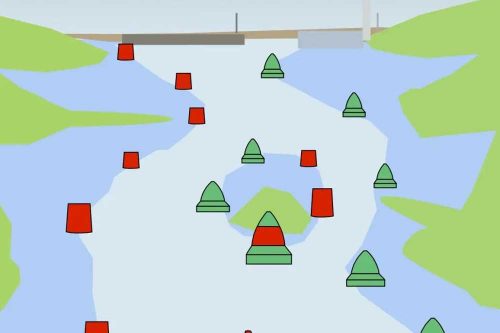What are the differences between the two IALA buoyage systems, IALA Region A and IALA Region B, and where are they used?
As recently as the 1970s there were more than 30 buoyage systems in use around the world. This caused confusion and accidents and it was after two fatal incidents in the Dover Straits in 1971 that the IALA (International Association of Marine Aids to Navigation and Lighthouse Authorities) was established. There followed a worldwide effort to develop a safe, unified maritime buoyage system that could be followed by all vessels at sea.
This resulted in the IALA Maritime Buoyage System and by 1980 there were just 2 systems in use, IALA A and IALA B. Although there is not as yet one unified system for the whole world, this was a major achievement nonetheless and the differences between IALA A and IALA B are only minor. The IALA chose the two systems in order to keep the number of changes to existing systems to a minimum and to avoid major conflict.
IALA REGION A
IALA A is used by countries in Africa, most of Asia, Australia, Europe and India.
IALA REGION B
IALA B is used by countries in North, Central and South America, Japan, Korea and the Philippines.
Take our IALA Buoys & Lights Quiz right now to see how much you know! Just click here.
The differences – lateral marks
The difference between the two systems is the colour and light characteristics used for lateral marks, as follows:
• IALA REGION A port lateral marks and lights are coloured red. IALA A starboard lateral marks and lights are coloured green.
• IALA REGION B port lateral marks and lights are coloured green. IALA B starboard lateral marks and lights are coloured red.
Lateral marks indicate the port and starboard sides of navigable channels. These are used in accordance with the direction of buoyage for the region or specific location, as indicated on marine charts. Where a channel divides a modified or “preferred” channel mark may be used to indicate the preferred route to take. In IALA Region A the lateral marks on the starboard side of the channel are coloured green and should be passed on the starboard side of the vessel. Those on the port side of the channel should be passed on the port side of the vessel. In IALA Region B the lateral marks on the starboard side of a channel are coloured red and on the port side are coloured green.
The similarities – all other types of buoy
Aside from the different lateral marks, both systems use identical cardinal, isolated danger, safe water and special marks. In 2006 new danger marks were introduced, see details below.
Cardinal Marks
Cardinal marks warn of hazards to be avoided such as shallows or rocks. Their markings and shape indicate which side of a buoy a vessel should pass and are placed either to the north, south, east or west of a hazard. Therefore a vessel should pass to the west of a west cardinal mark, or to the east of a east cardinal mark and so on. They are painted in combinations of yellow and black and have two distinct cone shapes on top, arranged in different combinations to help identify them.
Isolated Danger Marks
Isolated danger marks are used to indicate a single hazard, such as a wreck, which has navigable water all around it. Vessels should keep well clear of the mark on all sides. They are coloured black with red bands and have two black balls above each other on the top of the mark.
Safe Water Marks
Safe water marks indicate there is safe water all around the mark. They are used at the start of a buoyed channel when approaching a harbour from the sea. They coloured with red and white vertical stripes.
Special Marks
Special marks are not intended primarily as navigation marks. They are used to mark the boundaries of areas used for recreation eg water skiing or bathing, as racing marks and also for naval activities such as gunnery ranges. Special marks are coloured yellow and can be a variety of shapes.
New Danger Marks
New danger marks were introduced in 2006 and are used as emergency marks for recent wrecks or new hazards which do not appear on nautical charts. They are coloured with blue and yellow vertical stripes.
___________________
Safe Skipper apps have recently updated our Buoys and Lights app, which includes a full illustrated guide and a very useful test yourself section – see here.
Or – take our IALA Buoys & Lights Quiz right now to see how much you know! Just click here.











